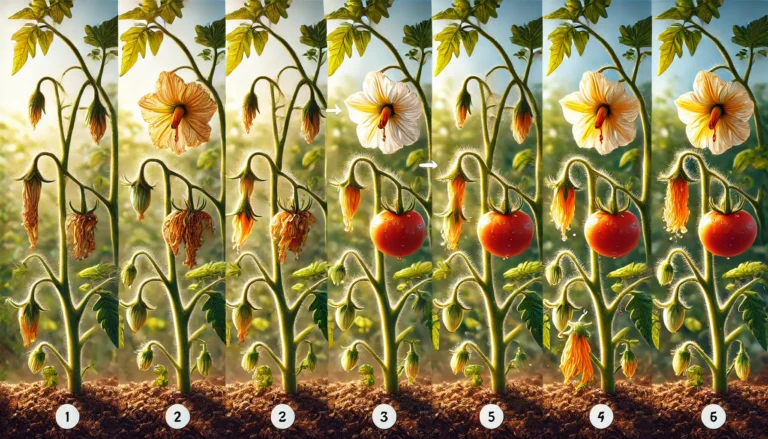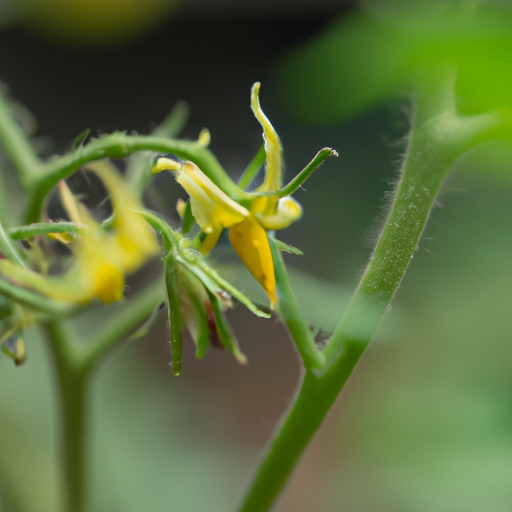As a gardener, I know how frustrating it can be to put in all the work of planting tomato plants only to see them fail to produce fruit.
Pollination is one of the key factors determining whether your tomatoes will bear fruit. Pollination is the process by which pollen from the male reproductive organ (anther) of a flower fertilizes the female reproductive organ (stigma) of another flower or within the same flower.
Pollination in tomato plants is crucial because it determines whether your plant will produce fruit or not. Without pollination, you may end up with many green tomatoes that never turn red and are unsuitable for consumption.
In This Article
How To Tell If Tomato Flower Is Pollinated?
Understanding how to tell if a tomato flower is pollinated can help you take steps to improve your plant’s chances of producing high yields and delicious fruits. So let’s explore this topic further and learn some techniques that can help us maximize our tomato yield!
Key Takeaways
- Signs of successful pollination include wilted petals, swelling ovary, and fruit development.
- Factors affecting pollination include temperature, humidity, and bee activity.
- Tomato plants rely on pollinators such as bees and butterflies for successful pollination.
- Techniques to improve pollination success include planting companion plants and hand pollination.
Understanding the Importance of Pollination in Tomato Plants
You need to understand the importance of pollination in your tomato plants if you want to see juicy and flavorful tomatoes on your plate.
Tomato plants rely on pollinators, such as bees, butterflies, and even wind, to transfer pollen from the male reproductive organs (anthers) to the female reproductive organs (stigma) of their flowers. This process leads to fertilization and, eventually, the formation of fruit.
However, there are common pollination problems that can affect tomato plants. For example, some varieties have closed flowers that require vibration for proper pollination – without it, tomatoes may remain small or not develop at all.
Additionally, pesticides can kill off beneficial insects like bees and disrupt natural pollination processes.
Understanding these issues can help you take steps to ensure successful pollination for your tomato plants. With this knowledge in mind, let’s move into identifying whether or not your tomato flowers have been successfully pollinated!
Identifying Pollinated Tomato Flowers
When I’m trying to identify pollinated tomato flowers, there are a few key points I always keep in mind. First and foremost, the appearance of the flower will change once it’s been successfully pollinated.
Observing the growth and development of the fruit can provide clues as to whether or not pollination was successful. Finally, there are a few signs that indicate when a flower has been successfully pollinated and will eventually produce ripe fruit.
So, paying attention to these details is important if you’re trying to identify pollinated tomato flowers.
Appearance of Pollinated Flowers
After pollination, the tomato flower will begin to show signs of fertilization through changes in its appearance.
One of the most noticeable changes is the wilted petals that start to fall off from the base of the flower. This happens because, after pollination, the petals aren’t necessary for attracting pollinators and protecting reproductive structures.
Another important change can be observed at the bottom of the flower, where a small green knob-like structure called an ‘ovary’ starts swelling up. This ovary will eventually develop into a fruit as long as it’s been properly fertilized during the pollination process.
Additionally, you may also notice that some flowers stop growing while others continue developing into fruits. These are all clear indications that your tomato plant reproduction is successful, and you should expect a good yield in the near future.
Observing the Growth and Development of Fruit
As you watch your tomato plant grow, take note of the swelling ovary at the base of some flowers. This is where pollination occurs and signals that fruit development has begun.
It’s important to regularly observe the growth and development of your tomatoes to ensure they’re progressing as expected. Measuring progress involves monitoring the size, colour, and texture of the fruit as it develops.
Troubleshooting issues, such as stunted or misshapen fruit, may indicate a lack of pollination or other environmental factors affecting growth.
By closely observing your tomato plants, you can identify any potential issues early on and take the necessary steps to ensure a successful harvest. With proper care and attention, you’ll soon see signs of successful pollination in your growing tomatoes.
Keep an eye out for these indicators in the upcoming section.
Signs of Successful Pollination
You can easily identify signs of successful pollination in your growing tomatoes. However, common misconceptions suggest that the formation of a tomato flower is enough to guarantee fruit development, but this is not true.
In order for the flowers to turn into fruits, they must be pollinated either by an external source or through self-pollination.
Pollination methods vary depending on the variety of tomatoes and environmental factors, such as wind and insects. Signs of successful pollination include the appearance of small green fruit at the base of the flower, which will start to grow rapidly after being fertilized.
You may also notice a slight swelling around the base of the flower stem and a wilted appearance of the petals once they have served their purpose in protecting the developing fruit.
Understanding these signs will help you determine if your tomato flowers are successfully pollinated and ensure that you are on track for a fruitful harvest.
Moving on to factors affecting pollination, it’s important to consider how temperature, humidity, and plant spacing can impact your success rate.
Factors Affecting Pollination
- Pollination is a crucial step in tomato production, and it plays a significant role in determining the fruit’s quality, size, and yield. Several factors can affect pollination success, including temperature, humidity, wind speed, and bee activity. These variables influence pollen viability and transferability and ultimately determine if the flower will be successfully fertilized or not.
- Pollination timing is also essential for a successful fruit set. Tomato flowers are receptive to pollination for only one day on average. The best time to pollinate them is early in the morning when temperatures are cooler because high temperatures can reduce pollen viability. It’s also important to note that insufficient bee activity can lead to poor pollination rates, which may result in small or misshapen fruits.
- By understanding these factors affecting pollination success, you can take steps to improve your chances of getting a good harvest. You can use several techniques to improve your chances of successful pollination without using artificial methods such as hand-pollinating or spraying hormones on flowers. These techniques include increasing bee activity by providing nesting sites for wild bees or keeping honeybees; planting companion plants that attract bees; maintaining proper soil moisture levels; avoiding excessive pesticide use during flowering periods; and selecting cultivars that produce more attractive flowers to bees.
- By implementing these techniques effectively, you can increase your yield and ensure high-quality fruits throughout the growing season without relying solely on artificial means to achieve this goal.
Techniques to Improve Pollination Success
- Boosting pollination success is achievable by implementing various techniques. One of the most effective ways to increase pollinator attraction is by planting companion plants alongside tomato plants. Plants such as marigolds, basil, and borage are known to attract bees and other pollinators to the garden. These beneficial insects help transfer pollen from one flower to another, leading to successful fertilization.
- Another technique that can be used to improve pollination success is hand pollination. This method involves using a small brush or cotton swab to transfer pollen from the male flower’s anther onto the female stigma. This ensures that each tomato flower receives enough pollen for fertilization, thus increasing the chances of fruit development.
- Maintaining proper soil moisture levels also plays a vital role in promoting bee activity and improving overall plant health. By incorporating these techniques into your gardening practices, you can significantly improve your tomato yield and enjoy a bountiful harvest.
- Maximizing tomato yield requires attention to detail when it comes to pollination success. Techniques such as companion planting, hand pollination, and maintaining proper soil moisture levels can all contribute towards achieving this goal.
In the next section, I’ll share some additional tips on how you can take your tomato-growing game up a notch!
Tips for Maximizing Tomato Yield
- Just like a skilled chef knows that the secret to a delicious dish lies in the right ingredients and preparation techniques, maximizing tomato yield requires careful attention to factors such as pruning, fertilization, and disease prevention.
- Pruning methods play a significant role in the growth and health of tomato plants. It’s essential to remove any suckers or side shoots that grow from the main stem as they compete for nutrients and reduce overall yield.
- Additionally, removing lower leaves can improve air circulation around the plant, reducing the risk of fungal diseases.
- Watering techniques are also crucial for maximizing tomato yield. Overwatering can lead to root rot, while under-watering can cause blossom-end rot. A consistent watering schedule is necessary, ensuring that the soil remains moist but not soaked.
- Applying mulch around the base of each plant can also help regulate soil moisture levels.
- By paying close attention to pruning methods and watering techniques, gardeners can ensure their tomatoes reach their full potential in terms of both quantity and quality.
FAQs: How To Tell If Tomato Flower Is Pollinated?
What are the benefits of pollination in tomato plants?
As a tomato plant grower, I understand the importance of pollination in maximizing crop yields. The benefits include improved fruit quality and increased production. Techniques like hand pollination and attracting pollinators can help achieve these results.
How can you tell if a tomato flower has been pollinated?
As I inspect my tomato plants, I notice the vibrant yellow stamen in the centre of each flower. If it’s wilted and droopy, no pollination occurs. A healthy stamen means a successful pollination process!
What are some factors that can negatively affect pollination in tomato plants?
Factors affecting pollination in tomato plants include temperature, humidity, wind, and lack of pollinators. Common pollination problems in tomatoes are blossom drop and poor fruit set. Proper management of these factors can improve pollination success.
Are there any techniques you can use to increase the chances of successful pollination in tomato plants?
To increase pollination, I use the technique of hand pollination by gently transferring pollen from the stamen to the pistil. Alternatively, natural pollination can be encouraged by providing a habitat for beneficial insects and avoiding pesticide use.
What are some tips for maximizing tomato yield once pollination has occurred?
Prune excess foliage to allow sunlight penetration and airflow to maximise tomato yield after pollination. Water regularly, fertilize with balanced nutrients, and remove any diseased fruits or leaves promptly to prevent spread.
Conclusion
In conclusion, ensuring successful pollination of your tomato plants is crucial for a bountiful harvest.
Just like the bees that tirelessly flit from flower to flower, we must be diligent in our efforts to ensure each and every tomato flower is adequately pollinated.
Think of it as a dance between the plant and its pollinators – a graceful exchange of pollen for nectar.
By understanding the factors that affect pollination, identifying pollinated flowers, and employing techniques to improve success rates, we can maximize our tomato yield and reap the sweet rewards of our labour.
So let’s don our bee suits and tend to our gardens with care, for there’s nothing quite like the taste of freshly picked tomatoes straight from the vine.



